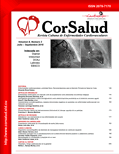Surgical treatment of femoral artery pseudoaneurysm after cardiac catheterization
Abstract
Today, femoral artery pseudoaneurysm is one of the most common iatrogenic complications. There are many treatment variants, where non-invasive procedures are the most used; however, surgery remains an effective alternative. A patient with a diagnosis of femoral artery pseudoaneurysm following a cardiac catheterization by electrophysiological study is presented, who two months after procedure began with a volume increase in the right inguinal region, functional impotence and auscultation of a murmur. Excision of the pseudoaneurysm and repair of the femoral artery with vascular prosthesis was performed. Eight months later, the patient underwent an evolutionary ultrasound, demonstrating the favorable evolution (normal flow and fully endothelized prosthesis).Downloads
Download data is not yet available.
Downloads
Published
2016-07-24
How to Cite
1.
Valdés Dupeyrón O, Mejides Díaz R, Cruz Martínez A, Suárez Rivero A, Zambrano Vásquez KB, Zambrano Parrales AL. Surgical treatment of femoral artery pseudoaneurysm after cardiac catheterization. CorSalud [Internet]. 2016 Jul. 24 [cited 2025 Dec. 17];8(3):189-93. Available from: https://revcorsalud.sld.cu/index.php/cors/article/view/141
Issue
Section
CASE REPORTS
License
Authors who publish with this journal agree to the following terms:- Authors retain copyright and grant the journal right of first publication with the work simultaneously licensed under a Creative Commons Attribution License that allows others to share the work with an acknowledgement of the work's authorship and initial publication in this journal.
- Authors are able to enter into separate, additional contractual arrangements for the non-exclusive distribution of the journal's published version of the work (e.g., post it to an institutional repository or publish it in a book), with an acknowledgement of its initial publication in this journal.










